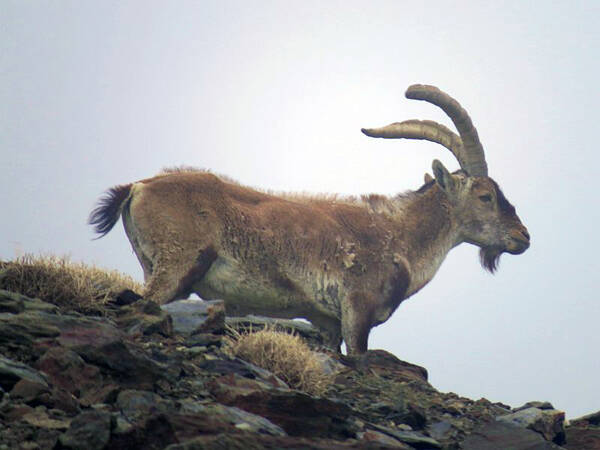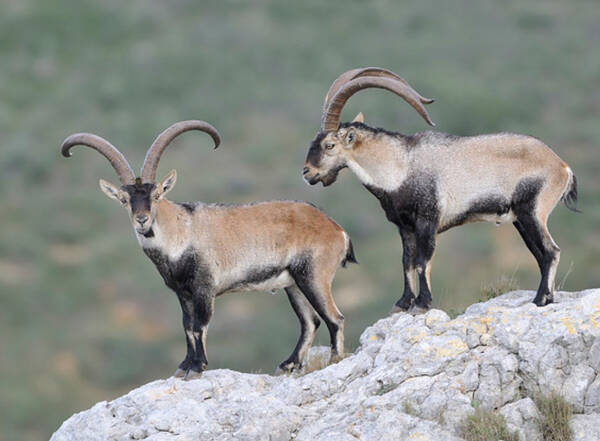Capra pyrenaica
IUCN
LCBasic Information
Scientific classification
- name:Capra pyrenaica
- Scientific Name:Iberian ibex, Iberian wild goat, Spanish goat, Iberian wild goat, Alpine wild goat
- Outline:Ungulata
- Family:Artiodactyla Bovidae Capra
Vital signs
- length:100-140cm
- Weight:35-80kg
- lifetime:About 19 years
Feature
The male's horns are farther apart than those of other species.
Distribution and Habitat
Native (residence): Spain.
Extinct: Andorra, France, and Gibraltar.
Reintroduced (residence): Portugal.
Historically found throughout the Iberian Peninsula, including the French Pyrenees. Of the four subspecies described, only two survive: the western Spanish subspecies (Capra pyrenaica victoriae) and the southeastern Spanish subspecies (Capra pyrenaica hispanica). The western subspecies occurs in the central Iberian mountain range of the Sierra de Gredos and has been reintroduced into many other parts of Spain and the Serra do Xurés, from where it spread into Portugal, and France. The southeastern subspecies occupies an arc of mountains along the Mediterranean coast, from the province of Cádiz to the Pyrenees (Montgrímica, a site of escape spread). They have also been reintroduced in some sites in Spain (Montserrat). The Portuguese subspecies (Capra pyrenaica lusitanica) lived in Lusitanica, northern Portugal, and became extinct in the late 19th century. The Pyrenean subspeci
Appearance
The Spanish ibex is 65-75 cm tall at the shoulder, 100-140 cm long, weighs 35-80 kg, and has a tail length of 10-15 cm. It is a species that exhibits strong sexual dimorphism. Males are larger in size and weight than females. Both sexes have horns, which are much larger and very thicker in males than in females, and can be three times as large and more developed. The horns of males are 75 cm or longer. The horns curve upward and outward, either upward or downward, depending on the subspecies. Annual horn growth is mainly affected by age, but can also be affected by environmental factors and growth in the previous year. The horns of males are farther apart from each other than those of other species in the same genus. Adult males also have a longer face with a typical black goatee under the chin. The species is characterized by large and flexible hooves and short legs. These physiological adaptations allow them to run and jump on exposed, rocky, rough and steep slopes that are out of re
Details
Spanish ibex (scientific name: Capra pyrenaica) is called Iberian Wild Goat, Iberian Ibex in English, Bouquetin Ibérique in French, Cabra Montesa, Cabra Montés in Spanish, Iberiensteinbock, Spanischer Steinbock in German, and Cabra-montês in Portuguese. There are 4 subspecies.

Spanish ibexes exhibit herding behavior. For most of the year, males and females with young ibexes are separated into separate groups. One-year-old ibexes usually move in the center of the group to protect them from predators. Females tend to be solitary during the birthing season, leaving the group to give birth and rejoining the group several days later. In the fall, the mixed-sex groups of adults separate from the mixed-sex groups of young ibexes. In the adult herd, a dominant male socializes with multiple females. There is a strict hierarchy of dominance between males, and only the dominant male has the right to mate. The dominant male protects his territory and the female group from other males. Males form a hierarchy and defend their territory with aggressive postures and fighting by butting heads. After the breeding season, the adult male and female groups separate again.
The Spanish ibex is a herbivore, feeding on grasses, mosses, flowers, leaves and twigs of plants. The main feed is holly oak, eating young leaves and acorns of these large evergreen oak trees. The Spanish ibex also feeds on weeds (5% of the diet) and grasses (10% of the diet). Weeds and grasses are more selected in spring and early summer. If leaves and twigs are beyond their reach, they will stand on their hind legs to eat these foods. They feed during the dusk and night, starting from the high steep cliffs and moving to the lower Alpine meadows. The rest of the time they stay on the higher cliffs and slopes to avoid attacks from predators. In winter, due to the scarcity of food, Spanish ibex tend to live in lower altitudes. In summer, they choose to live near water sources because they need to drink water every few days.
The breeding season of Spanish ibex occurs from November to December, reaching a peak in early December. Females in estrus signal to males that they are ready to mate by producing certain pheromones. During estrus, males will fight for the right to mate by butting their heads. The gestation period is 161-168 days. The peak breeding period is mid-May. Females breed once a year, usually giving birth to 1-2 young per litter. Females usually find a remote, inaccessible area with thick underbrush to give birth. After giving birth, female Spanish ibexes and their young congregate in groups. Males reach sexual maturity at 3 years of age, and females at 1.5.

The Spanish ibex population is estimated to be well over 100,000 individuals throughout its range (García-González et al., 2020). These species numbers include the Sierra Nevada (15,000 individuals), the Sierra de Gredos (8,000 individuals), the Iberian system (more than 50,000 individuals), the Serranía de Ronda and Sierra de Grazalema (4,000 individuals), the Pyrenees (more than 600 individuals), the Sierra de Cazorla (2,500 individuals), the Sierra Tejeda and Sierra Almijara (2,500 individuals), the Sierra de Antequera (2,000 individuals), all in Spain. In Portugal and Spain, in the Peneda Guerreira National Park, Baixa Limia and Serra do Xurés Natural Park and their surroundings (more than 600 individuals); in the French Pyrenees, there are two populations (about 400 individuals) and in the Spanish Pyrenees, there are more than 400 individuals. This number has been expanding since the early 1990s (1997).
Listed in the IUCN Red List of Threatened Species in 2020 ver3.1 - Least Concern (LC).
Protect wild animals and eliminate game.
Maintaining ecological balance is everyone's responsibility!








